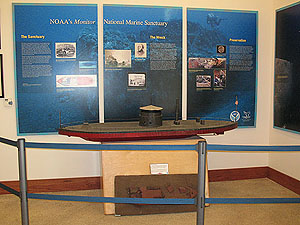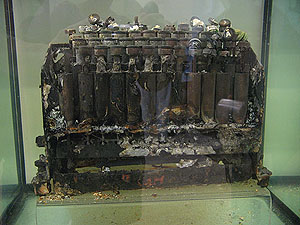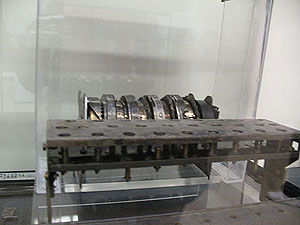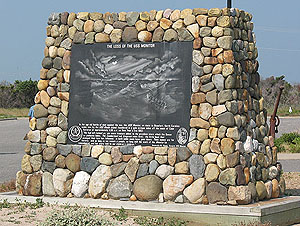
 |
The artifacts below are from two places -- The Graveyard of the Atlantic museum in Hatteras, and the museum at the Cape Hatteras Lighthouse. The Graveyard of the Atlantic museum houses artifacts from several different shipwrecks, but to me, the most impressive display is that of the original Lens from the 1854 Cape Hatteras Lighthouse. The "First Order |
|
Fresnel Lens" is the largest type of Fresnel Lens, made up of more than a thousand glass prisms which bend the light into a narrow beam. This beam could be seen as far as 20 miles off the coast of NC. At the onset of the Civil War, the Confederates removed all the lenses from the lighthouses so as to hamper any Union attacks from the sea. The Cape Hatteras Lens, removed in 1861, remained hidden throughout the civil war, but afterward was shipped back to Paris for repairing. Once it was repaired, it was returned to the United States and housed in the Lighthouse Depot on Staten Island to await placement, once again, in a lighthouse. Until 2002, we didn't know which United States lighthouse received the orginal Cape Hatteras Lens. Through research, author and historian Kevin Duffus was able to compile a short list of lighthouses that were possibilities. One of these lighthouses worried him, for he knew the fate of the lens that was housed there. Upon further research, however, he discovered that the lens had been placed back at Cape Hatteras in 1871. It was, unfortunately, in this very lighthouse which Kevin Duffus hoped the lens had not been placed, because he knew that years ago vandals had climbed the lighthouse with sledge hammers and screwdrivers in hand and |
 |
|
| destroyed most of the prisms of the lens. The original lens and clockwork pedestal have since been removed from the lighthouse and preserved, in its damaged state, in the Graveyard of the Atlantic museum. We were lucky enough to have Kevin Duffus come and speak with us at this NCCAT seminar, and when asked why the lens wasn't restored for display, he responded that he thought it was important that we learn to preserve these artifacts from our history, and I have to agree with him. The sight of this beautiful lens missing most of its prisms can hopefully help teach us this lesson. | ||
 |
 |
|
| This is a scale model of the USS Monitor, which was sunk by bad weather during the Civil War. | On our tour of the unfinished Graveyard of the Atlantic Museum, we were lucky enough to be given a "backstage tour", in which we saw many artifacts collected from shipwrecks and shores of the NC Coast. Once the museum is completed, these artifacts will have a home where they can be viewed by the public. | |
 |
 |
|
| During World War II, German U-boats were a major threat to the Allied war effort. These German submarines carried the "Enigma" machine -- an encryption machine which made it possible for the German armed forces to communicate without fear of their codes being deciphered by the enemy. The Allied forces' only hope was to capture the Enigma machine, and the machine used to decipher its codes. The machines above were excavated from a German U-boat sunk off the coast of NC, and were important in "turning the tides" in World War II. It wasn't until the Enigma machines were obtained that the Allied forces were able to intercept German communications and mount an effective resistance to the U-boats. Until that point, the Allied forces were on the verge of losing the war. | ||
 |
 |
|
| This is one of several monuments placed around the parking lot of the Graveyard of the Atlantic Museum. This particular one is a monument to the USS Monitor. Its inscription says:
|
This
submarine hatch cover is from the German U-boat U-85 sunk by the USS
Roper on April 14, 1942.The U-85 lies upright on the ocean floor at
a depth of approximately 100 feel and is a popular site for sport
divers. |
|